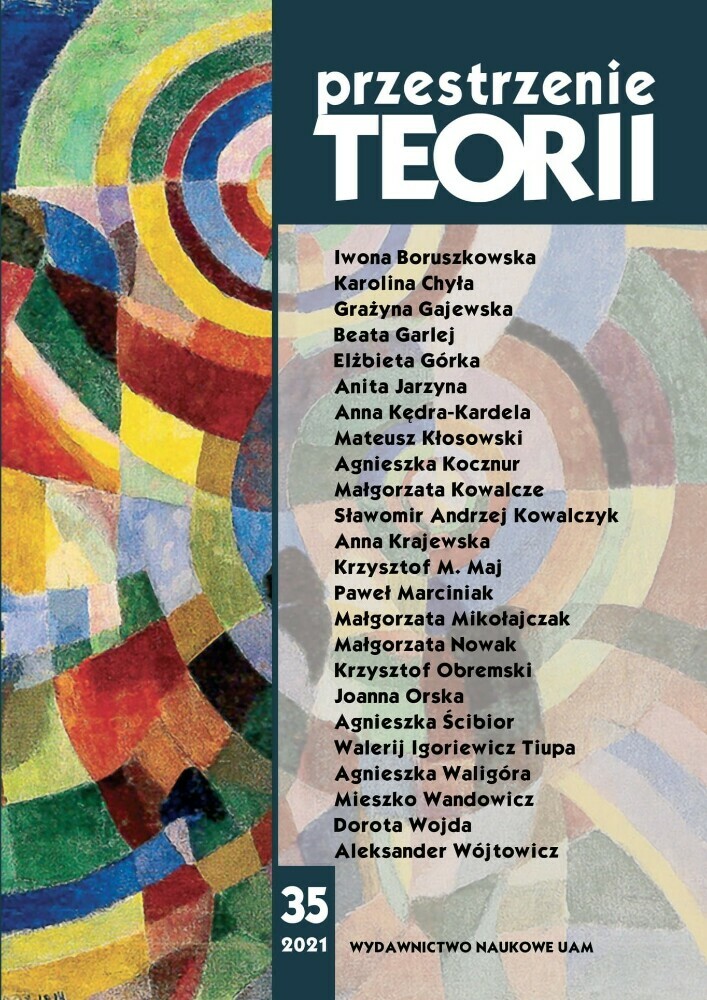Abstract
This paper considers The Masque of the Red Death, a short story by E.A. Poe. Understanding the carnival as mundus inversus (temporary inversion of order) and using the theories proposed by M. Bakhtin or V. Turner, the authors present an interpretation according to which Poe’s ball is indeed an inversion of a ball – an anti-carnival. Furthermore, they do not agree with the allegorical understanding of Poe’s works. Indicating a suggestion made by Poe himself, they choose an interpretation related to Eliade’s concept of symbolism. They also disagree with the theory in which The Masque of the Red Death is the story about the non-existence of God. Referring to other religious interpretations and the problems of time, they present their own biblical conclusion.
References
BIBLIOGRAFIA PODMIOTOWA
Eureka: A Prose Poem, <https://www.eapoe.org/works/editions/eurekac.htm> [dostęp: 26.02.2021].
Maska czerwonej śmierci, [w:] E.A. Poe, Nowelle, tłum. B. Beaupré, Kraków 1909, s. 37–45.
Maska Śmierci Szkarłatnej, [w:] E.A. Poe, Opowieści nadzwyczajne, t. II, tłum. B. Leśmian, Warszawa 1913, s. 187–199.
Maska śmierci szkarłatnej, <https://wolnelektury.pl/katalog/lektura/maska-smierci-szkarlatnej.html> [dostęp: 3.03.2021].
The Masque of the Red Death, [w:] E.A. Poe, The Collected Works, Ware 2009, s. 247–251.
BIBLIOGRAFIA PRZEDMIOTOWA
Bachtin, M., Twórczość Franciszka Rabelais’go a kultura ludowa średniowiecza i renesansu, tłum. A. i A. Goreniowie, oprac. S. Balbus, Kraków 1975.
Biblia Tysiąclecia: Pismo Święte Starego i Nowego Testamentu w przekładzie z języków oryginalnych, red. K. Dynarski, M. Przybył, Poznań 2002.
Boholm Å., Weneckie widowiska karnawałowe, tłum. J. Jaworska, „Konteksty: Polska Sztuka Ludowa” 2002, nr 3/4, s. 147–150.
Cheishvili T., E.A. Poe’s The Masque of the Red Death: Symbol vs. Allegory?, „Journal of Literature and Art Studies” 2015, nr 9, s. 706–716.
Cook J.A., Poe and the Apocalyptic Sublime “The Masque of the Red Death”, „Religion and the Arts” 2019, nr 23, s. 489–515.
Dudzik W., Karnawały w kulturze, Warszawa 2005.
Edgar Allan Poe. Niedoceniony nowator, red. E. Kasperski, Ż. Nalewajk, Wrocław 2010.
Eliade M., Symbolizm a psychoanaliza, [w:] M. Eliade, Sacrum, mit, historia, tłum. A. Tatarkiewicz, Warszawa 1970, s. 25–34.
Fisher B.F., Poe and the Gothic Tradition, [w:] The Cambridge Companion to Edgar Allan Poe, red. K.J. Hayes, Cambridge 2002.
Goethe J.W., Rzymski karnawał, [w:] J.W. Goethe, Podróż włoska, tłum. H. Krzeczkowski, Warszawa 1980.
Haspel P., Bells of Freedom and Foreboding: Liberty Bell Ideology and the Clock Motif in Edgar Allan Poe’s “The Masque of the Red Death”, „The Edgar Allan Poe Review” 2012, nr 1, s. 46–70.
Herndon J.A., The Masque of the Red Death: A Note on Hawthorne’s Influence, [w:] Masques, Mysteries and Mastodons: A Poe Miscellany, red. B.F. Fisher, Baltimore 2006, s. 38–44.
Hoffman G., Space and symbol in the tales of Edgar Allan Poe, „Poe Studies” 1979, nr 1, s. 1–14.
Krutch J.W., Edgar Allan Poe: A Study in Genius, New York 1926, s. 77.
Kunicki W., Symetria i symbolika. O roli figur w „Marmurowych Skałach” Ernsta Jüngera, „Literatura na Świecie” 1986, nr 9 (182), s. 147–176.
Leśmian B., Pururawa i Urwasi, [w:] tegoż, Dzieła wszystkie. Poezje zebrane, Warszawa 2012, s. 243–247.
Lovecraft H.P., Nadnaturalny horror w literaturze, tłum. A. Ledwożyw, Ł.M. Pogoda, R. Lipski, Warszawa 2008.
Pfrunder P., Główne koncepcje historycznych badań karnawału, tłum. A. Brańka--Banasiak, [w:] Karnawał. Studia historyczno-antropologiczne, red. W. Dudzik, Warszawa 2011, s. 29–50.
Quinn A.H., Edgar Allan Poe, New York 1941, s. 331.Roppolo J.P., Meaning and “The Masque of the Red Death”, „Tulane Studies in English” 1963, nr 13, s. 59–69.
Rudolf E.I., Od dżumy do Eboli. Sposób przedstawienia wybranych chorób zaraźliwych w przykładowych tekstach literatury popularnej, Wrocław 2019.
Rymkiewicz J.M., Leśmian. Encyklopedia, Warszawa 2001.
Tolkien J.R.R., Letters, red. H. Carpenter, Ch. Tolkien, New York 2013.
Turner V., Karnawał, rytuał i zabawa w Rio de Janeiro, tłum. A. Brańka-Banasiak, W. Dudzik, [w:] Karnawał. Studia historyczno-antropologiczne, red. W. Dudzik, Warszawa 2011, s. 291–314.
Wandowicz M., Dwa studia o śmierci i tożsamości, „Kronos. Metafizyka, kultura, religia” 2020, 2, s. 200–212.
Watson Ch.N., “The Mask of the Red Death” and Poe’s Reading of Hawthorne, „The Library Chronicle” 1981, nr 1–2, s. 143–149.
Wheat P.H., The Mask of Indifference in “The Masque of the Red Death”, „Studies in Short Fiction” 1982, nr 1, s. 51–56.
License
Authors
Authors of texts accepted for publication in Przestrzenie Teorii are required to complete, sign and return to the editor's office the Agreement for granting a royalty-free license to works with a commitment to grant a CC sub-license.
Under the agreement, the authors of texts published in Przestrzenie Teorii grant the Adam Mickiewicz University in Poznań a non-exclusive, royalty-free license and authorize the use of Attribution-NonCommercial-NoDerivatives 4.0 International (CC BY-NC-ND 4.0) Creative Commons sub-license.
The authors retain the right to continue the free disposal of the work.
Users
Interested Internet users are entitled to use works published in Przestrzenie Teorii since 2015, for non-commercial purposes only, under the following conditions:
- attribution - obligation to provide, together with the distributed work, information about the authorship, title, source (link to the original work, DOI) and the license itself.
- no derivatives - the work must be preserved in its original form, without the author's consent it is not possible to distribute the modified work, such as translations, publications, etc.
Copyrights are reserved for all texts published before 2015.
Miscellaneous
Adam Mickiewicz University in Poznań retains the right to magazines as a whole (layout, graphic form, title, cover design, logo etc.).

